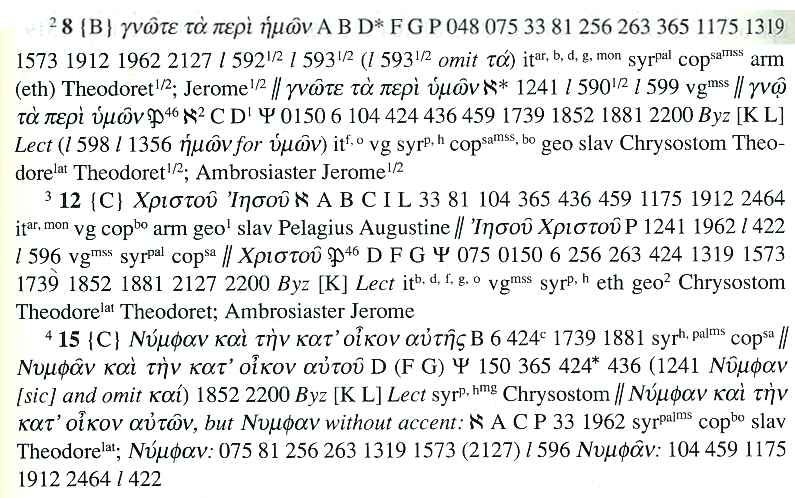 |
| 4:8, fn. 2 | 4:12, fn. 3 | 4:15, fn. 4 | 4:18, fn. 5 |
 |
PASSAGE: 4:8, footnote 2
|
Variant
Readings
|
Alexandrian
(Aland I-II)
|
Western
(Aland IV)
|
Unclassified
(Aland III)
|
Byzantine
(Aland V)
|
| gnw'te
ta; peri; hJmw'n
gnw'te ta; peri; uJmw'n
gnw'/ ta; peri; hJmw'n
|
EVALUATION OF EXTERNAL EVIDENCE
(1) Shorter/Longer Reading.
(2) Reading Different from Parallel.
(3) More Difficult Reading.
(4) Reading Which Best Explains Origin of Other(s).
2.Intrinsic Probabilities, i.e. what the author himself likely wrote.
Summary of Internal Evidence
CONCLUSION
 |
PASSAGE: 4:12, footnote 3
|
Variant
Readings
|
Alexandrian
(Aland I-II)
|
Western
(Aland IV)
|
Unclassified
(Aland III)
|
Byzantine
(Aland V)
|
| Cristou'
jIhsou'
Cristou'
|
EVALUATION OF EXTERNAL EVIDENCE
(1) Shorter/Longer Reading.
(2) Reading Different from Parallel.
(3) More Difficult Reading.
(4) Reading Which Best Explains Origin of Other(s).
2.Intrinsic Probabilities, i.e. what the author himself likely wrote.
Summary of Internal Evidence
CONCLUSION
 |
PASSAGE: 4:15, footnote 4
|
Variant
Readings
|
Alexandrian
(Aland I-II)
|
Western
(Aland IV)
|
Unclassified
(Aland III)
|
Byzantine
(Aland V)
|
| Nuvmfan
kai; th;n kat j oi\kon aujth'"
Nuvmfan kai; th;n kat j oi\kon aujtou'
Nuvmfan kai; th;n kat j oi\kon aujtw'n
|
EVALUATION OF EXTERNAL EVIDENCE
(1) Shorter/Longer Reading.
(2) Reading Different from Parallel.
(3) More Difficult Reading.
(4) Reading Which Best Explains Origin of Other(s).
2.Intrinsic Probabilities, i.e. what the author himself likely wrote.
Summary of Internal Evidence
CONCLUSION
 |
PASSAGE: 4:18, footnote 5
|
Variant
Readings
|
Alexandrian
(Aland I-II)
|
Western
(Aland IV)
|
Unclassified
(Aland III)
|
Byzantine
(Aland V)
|
| uJmw'n
uJmw'n. ajmhvn.
qeou' (for
meq j uJmw'n). ajmhvn.
th;n meta; pavntwn uJmw'n. ajmhvn.
|
EVALUATION OF EXTERNAL EVIDENCE
(1) Shorter/Longer Reading.
(2) Reading Different from Parallel.
(3) More Difficult Reading.
(4) Reading Which Best Explains Origin of Other(s).
2.Intrinsic Probabilities, i.e. what the author himself likely wrote.
Summary of Internal Evidence
CONCLUSION